Cornus canadensis, bunchberry dogwood, is a low growing native perennial herbaceous plant. It is also known as mayflower.
Flowers
Inflorescence
The bunchberry dogwood flowers are tightly clustered at the end of a stem surrounded by showy white bracts which look like petals. There are 4 bracts, each up to an inch long. The white bracts and the tiny flowers in the middle are frequently referred to as the 'flower' and technically it is a pseudanthium - an inflorescence that looks like a single flower but is composed of many flowers. The central flower cluster consists of 12-40 individuals. Below are 2 photos showing the inflorescence and the 'whorl' of leaves behind it.
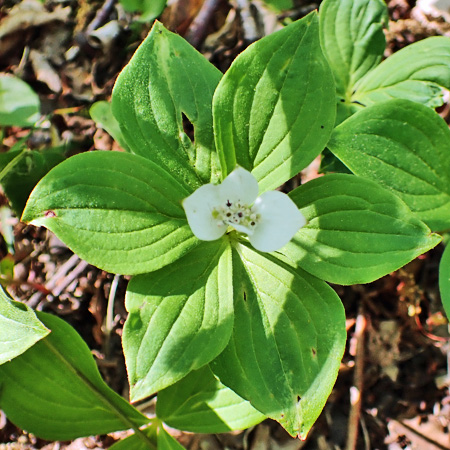
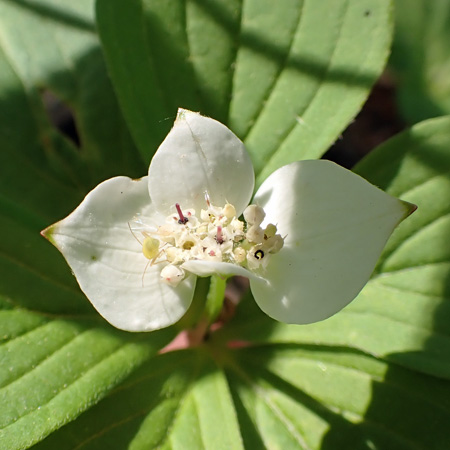
Flowers
The true flowers are only about 2 mm across. They have 4 creamy white petals that are attached at the top leaving the lower petal edges open. Inside the flower are 4 stamens (male part consisting of anther & filament) that are arranged between the petals. Also inside is a single pistil (female part consisting of stigma, style, and ovary). The ovary is inferior (ovary is below the attachment of the petals). At the base of the erect style is a nectar ring that is deep red. Outside, one or more of the petal tops will have a upward pointing projection.
The photo the below shows the upward pointing projections on the petal tops. One flower has four, one on each petal. The others only have one.
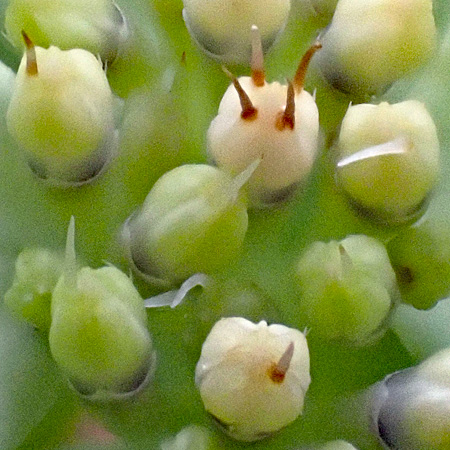
As the flower matures, the filament grows and no longer fits inside the flower, so the filament bends and sticks out in between the petals. The anthers remain inside the flower. These protruding filaments are shown with the red arrows in the photo below. The yellow arrows point to the upward projections from the petals.
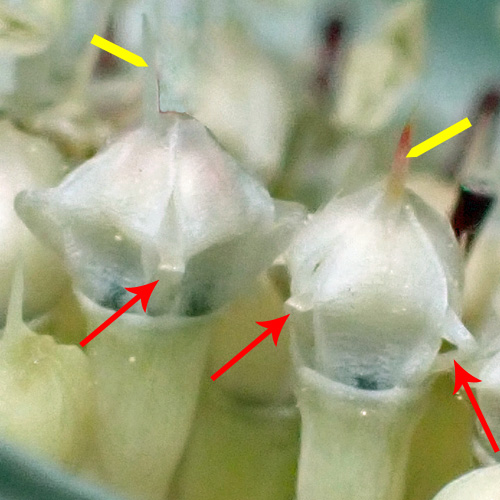
Pollen dispersal - explosive pollination
Very few flowers utiize explosive pollination. The flower structure that enables explosive pollination is discussed further. See the diagram below.
The upward projection ('t' in diagram) from the petal is a trigger which will cause the flower petals to open when touched.
Inside a mature flower, before opening, the anthers ('a' in diagram) have already released pollen along its longitudinal dehiscing line (yellow dots in diagram between the two anthers). However, each pair of adjacent anthers are aligned so that the dehiscing areas face and press against each other and hold the pollen in place. Sometimes the dehiscing anther surface is pressed against the style ('s' in diagram).
When the flower is triggered, the petals open, and the elastic energy stored in the elbow ('e' in diagram) of the filament straightens out the filament and swings the hinge connecting the anther to the filament ('h' in diagram) sending the pollen flying into the pollinating insect or into the air when self-opening.
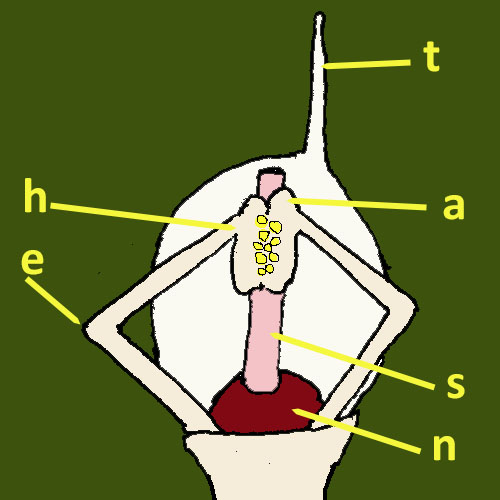
Simplified diagram - inside the flower before opening:
- t: trigger point on a petal
- a: anther that is dehiscing with pollen facing opposite anther
- s: style of pistil
- n: nectary ring at base of style
- h: hinge joint between anther and filament of stamen
- e: elbow of filament that extends beyond the petals and has the spring energy
Using high speed video, the flower was shown to open in less than half a millisecond which so far is the fastest movement in a plant. In 0.3 milliseconds, the anther accelerates up to 24,000 m/sec^2 (2,400 gravity) reaching a high speed of 3 m/sec to propel the pollen. The pollen reaches a height of 2.5 cm. (1 inch). It is turgor pressure, hydrostatic pressure, in the filament that powers the explosion. Details in first reference below.
What advantage does this type of pollen dispersal provide? It aids cross pollination by dispersing pollen only when it is triggered by an insect and the pollen is rapidly expelled into the insects body hairs helping the pollen stick. The force required to trigger the flower requires larger insects. When the flowers open by themselves, the pollen is expelled high enough so that the pollen can be carried by the wind for wind pollination. The pollen is scattered all over the blower but the flower is self-incompatible.
Photos below are opened flowers. Shown are the 4 partly reflexed petals, the 4 partly straightened out filaments with dehisced anthers with some pollen scattered around. The stigma, style and dark nectar ring can be seen.

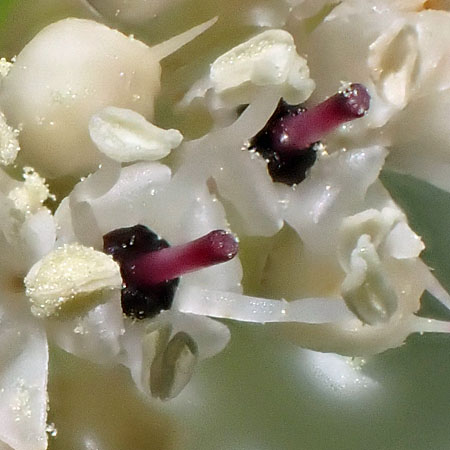
Fruit
Fruit
After pollination, the flower forms a round drupe, generally a cluster of drupes develop from the inflorescence. The drupe is a fleshy fruit with a hard central stone which gives rise to the name 'crackleberry' when eaten. Mature fruits are red-orange and immature fruits are yellow-green.

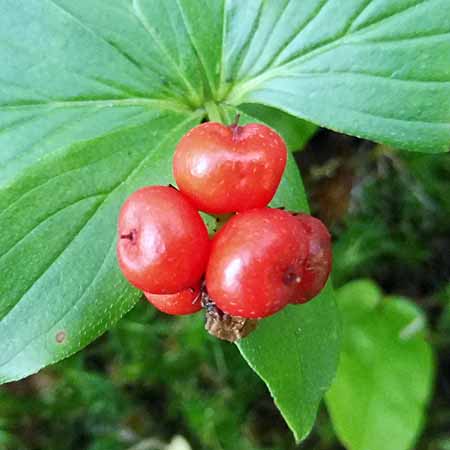
Leaves
The bunchberry dogwood vegetative / sterile shoots have 2 pairs of opposite leaves, bunched close together, at the top of the shoot. They appear to be a whorl of 4 leaves. The leaf upper surfaces have short appressed hairs.
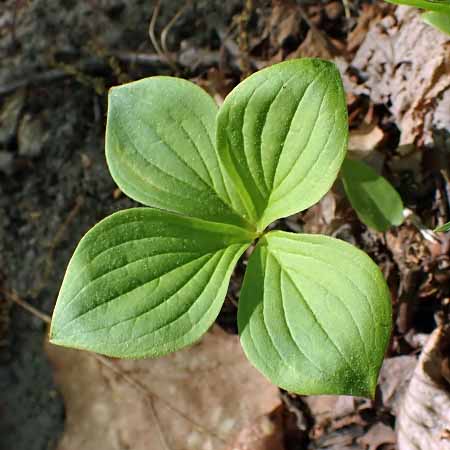

Fertile/flowering shoots have 3 pairs of opposite leaves just below the inflorescence. One pair is larger than the other 2 pairs. The smaller pairs grow from the axils of the larger leaves. See photo in the 'Plant & Habitat' section.
The leaves are an inch to 3.5 inches long and up to 2 inches wide.
Plant & Habitat
Bunchberry dogwood is 2 to 10 inches tall. It spreads by horizontal woody rhizomes and the buds send out sterile/vegetative shoots and flowering shoots. The rhizomes can form dense colonies of clones. The plant also spreads by seeds. It is an understory plant and is shade tolerant but does well with some light at edges and gaps in the forests. It likes moist and cool environments. It is mostly found as understory in boreal forests.
In NJ, bunchberry dogwood is S1 - Critically Imperiled. In iNaturalist, in NJ, July 2024, only 16 observations were reported all in north Jersey.

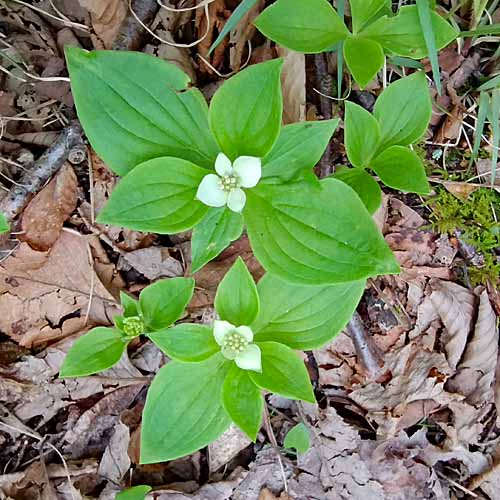
Text by Millie Ling and all photos by Hubert & Millie Ling. Photos: Sussex County & Ontario Province, Canada, flowers taken May & June 2024.
Additional information / References
Additional information / references:
- A study of explosive pollination with video recording was announced in May 2005, Edwards, Whitaker, Klionsky, Laskowski: A record-breaking pollen catapult. https://www.nature.com/articles/435164a PDF available
- Detailed paper using video recording and biomechanical modeling to study explosive pollination in bunchberry dogwood Cornus canadensis in Functional Ecology · February 2007 Whitaker, Webster, and Edwards: https://www.researchgate.net/publication/228040283_The_biomechanics_of_Cornus_canadensis_stamens_are_ideal_for_catapulting_pollen_vertically PDF available
- Excellent description and photos: https://newfoundland-labradorflora.ca/flora/dview/?id=434
- Good description Click Here
- NatureServe Click here